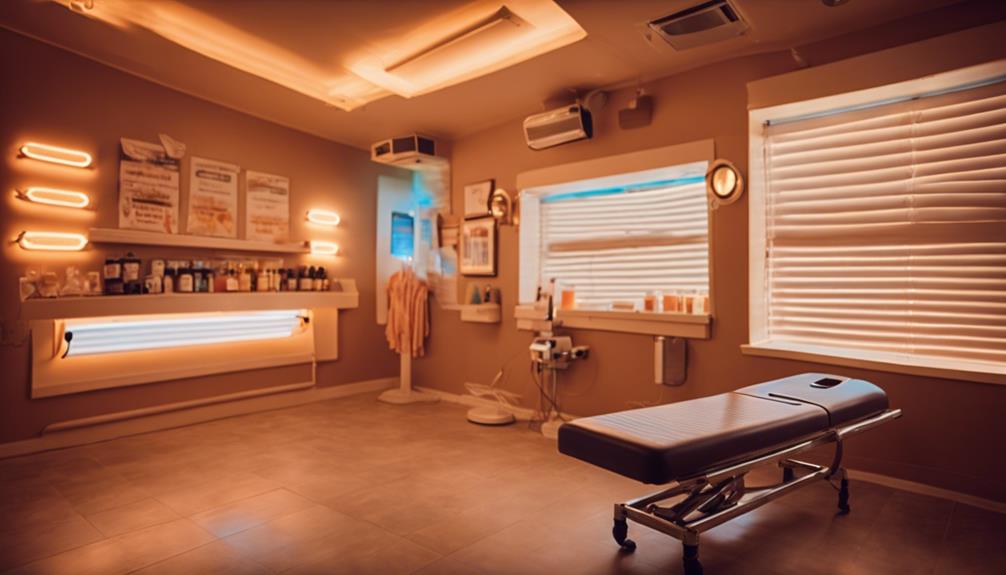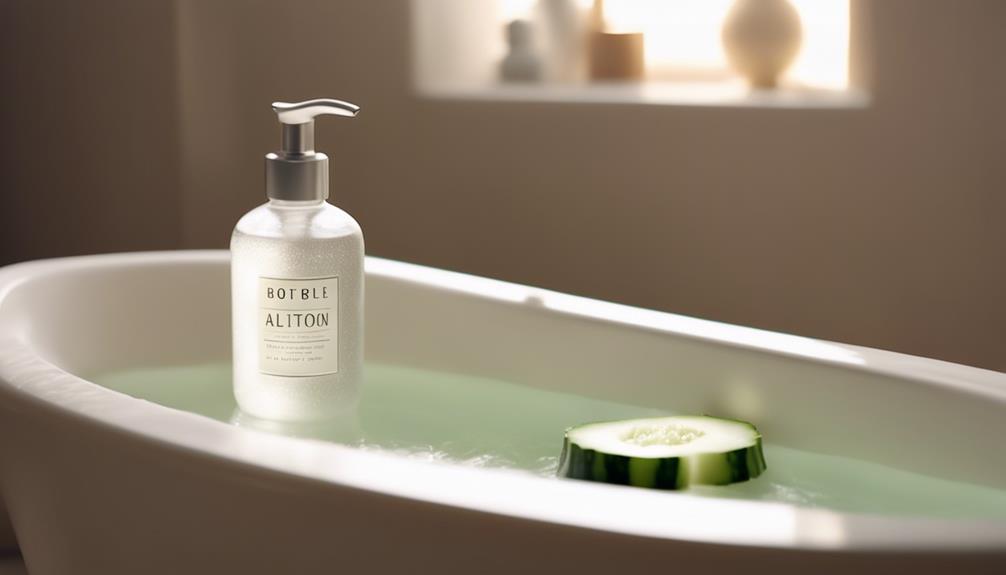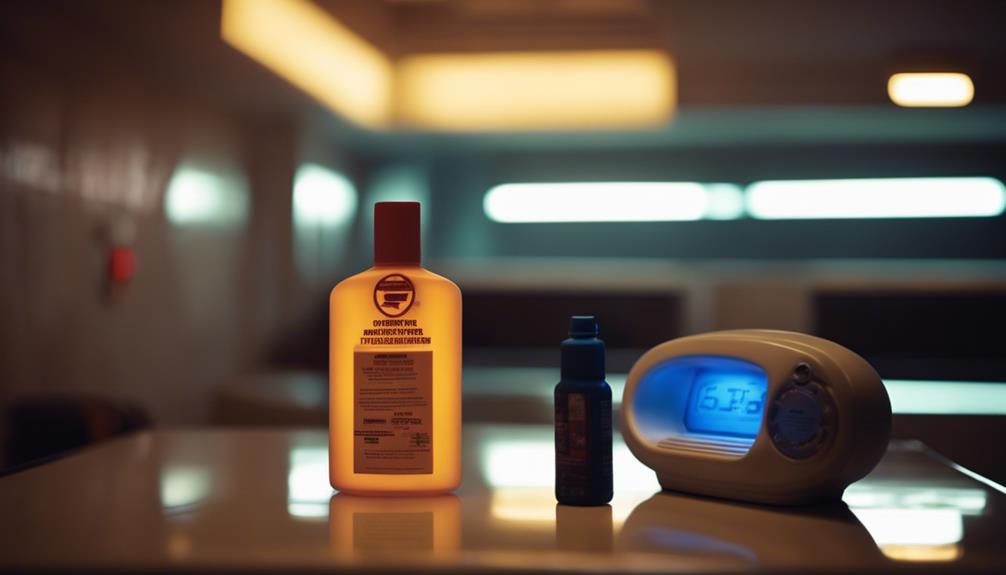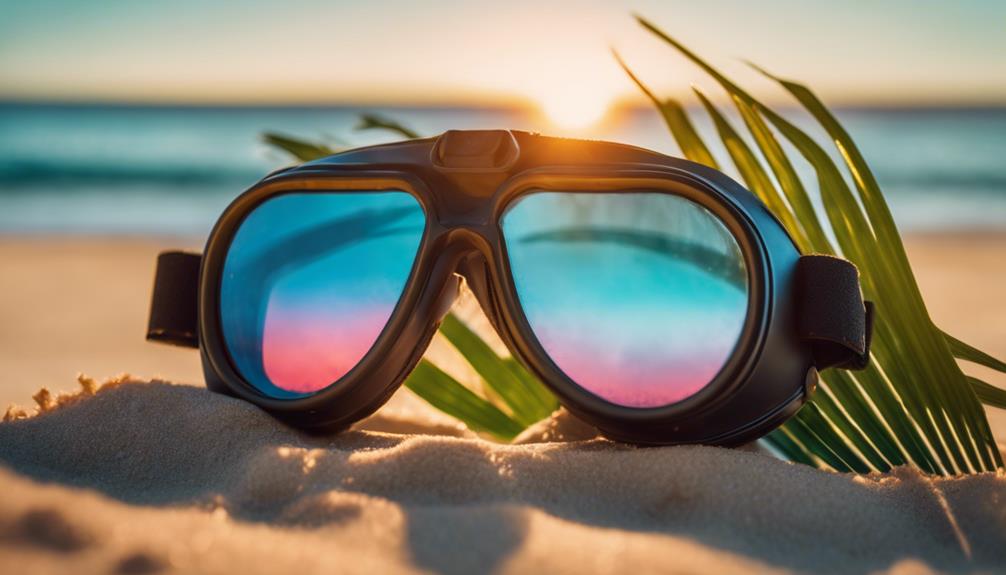As a new user of tanning beds, it is important to start off on the right foot. Determine your skin type to select the appropriate tanning lotion and always exfoliate 24 hours before your session. Begin with short sessions lasting 5-10 minutes and make sure to wear protective eyewear to shield your eyes from harmful UV rays. Remember to wait at least 48 hours between sessions to avoid overexposure. After tanning, apply a high-quality moisturizer to keep your skin hydrated and help maintain your tan. Keep an eye on your skin for any adverse reactions. There is a lot to discover for a flawless tanning experience that will leave you looking sun-kissed all season long.
Key Takeaways
- Start with short sessions of 5-10 minutes to allow your skin to adjust to UV exposure.
- Always wear protective eyewear to shield your eyes from harmful UV rays during tanning.
- Exfoliate your skin 24 hours before tanning for an even and smooth tan.
- Follow the 48-hour rule between tanning sessions to prevent skin overexposure and irritation.
Understanding Skin Sensitivity
Understanding your skin sensitivity is vital for choosing the right tanning method and achieving an even tan without risking damage.
Start by evaluating your skin type; consider taking a skin type quiz to see how your skin interacts with UV rays. If you're a first-time tanner, take time to understand your skin's reaction to sun exposure to prevent uneven tanning.
Exfoliating your skin 24 hours before tanning is critical, as is moisturizing to guarantee even results. Avoid using oils or lotions just before your session, and remember to stay hydrated to maintain skin elasticity.
If you're trying a new tanning product, do a patch test to prevent any adverse reactions. Consulting salon staff can also provide valuable insights tailored to your skin sensitivity.
Selecting Tanning Lotion
Choosing the right tanning lotion is essential for enhancing your tan while keeping your skin hydrated and healthy.
First, identify your skin type to select a lotion that complements it.
Look for products that offer deep hydration, as moisturized skin tans more evenly.
Consider lotions with bronzers for an instant glow and accelerated tanning results.
Apply the lotion evenly, ensuring full coverage, and let it dry before stepping into the tanning bed.
Avoid using oils or cosmetics not designed for tanning, as these can interfere with the tanning process.
Tanning Bed Safety Guidelines

Selecting the right tanning lotion sets the stage for a safe tanning experience, so it's important to follow specific safety guidelines when using tanning beds.
First, always wear protective eyewear to shield your eyes from harmful UV rays.
Start with short sessions of 5-10 minutes, gradually increasing your time as your skin adjusts.
Stick to the 48-hour rule between sessions to avoid overexposure.
Choose a Level One tanning bed for your initial visits, as it offers milder UV exposure.
Also, make sure to moisturize your skin before tanning and avoid oils or lotions not designed for tanning.
Finally, listen to your skin; if you notice any irritation, take a break and consult a professional.
Safety first!
Proper Tanning Duration
To achieve the best tan while minimizing the risk of burns, you should start with shorter tanning sessions and gradually increase the duration as your skin adapts.
For your initial visits, aim for 5 to 10 minutes in a Level One tanning bed. This helps your skin adjust without overwhelming it.
After each session, wait at least 48 hours before tanning again to allow your skin to recover. Pay attention to how your skin reacts; if you notice redness or irritation, reduce your time.
Always use protective eyewear to shield your eyes from harmful UV rays.
Essential Post-Tanning Care

After tanning, maintaining a proper skin care routine is essential to enhance and prolong your tan.
Start by applying a quality after-tan moisturizer, which helps lock in moisture and keeps your skin looking radiant.
Avoid hot showers right after tanning; instead, opt for a cool shower to preserve your color.
Use gentle cleansers that won't strip away your tan, and stay hydrated by drinking plenty of water to aid skin recovery.
Make sure to regularly check your skin for any irregularities, as this is important for your overall skin health.
Current Tanning Trends
2025's tanning trends highlight a growing preference for organic products and innovative technologies that prioritize skin safety and health.
You're likely to see an increase in demand for natural tanning lotions and self-tanners, which provide you with a radiant glow without harmful UV exposure.
LED tanning beds are also gaining popularity, offering a safer alternative that minimizes skin damage.
As awareness of skin cancer risks rises, many tanners are opting for eco-friendly solutions that combine effective results with skin protection.
Additionally, spray tans and bronzing powders are becoming go-to options for those seeking immediate color without the risks associated with traditional tanning.
Embracing these trends can help you achieve the perfect tan while caring for your skin.
Exploring Alternative Tanning Options

Exploring alternative tanning options can help you achieve a beautiful glow while minimizing the risks associated with UV exposure.
Consider trying spray tans, which provide an instant tan without harmful rays. Self-tanning lotions are another great choice, allowing you to build color gradually and avoid overexposure. If you prefer something immediate, bronzing powders can give you that sun-kissed look without any skin damage.
For a more eco-friendly approach, look for organic and natural tanning products that are gaining popularity in 2025. Additionally, LED tanning beds offer a safer alternative with less UV risk.
With these options, you can confidently enjoy a radiant tan while prioritizing your skin's health.
Frequently Asked Questions
How Often Should I Tan for Optimal Results?
To achieve ideal results, you should tan every 48 hours, starting with short sessions of 5-10 minutes. Gradually increase the duration as your skin adapts, and always prioritize skin safety and hydration.
Can I Tan if I Have a Sunburn?
You shouldn't tan with a sunburn; it can worsen your skin's condition and increase irritation. Instead, let your skin heal completely before considering any tanning to guarantee a safe and effective experience.
What Should I Wear in a Tanning Bed?
When you're using a tanning bed, wear comfortable, minimal clothing to avoid tan lines. Many prefer swimsuits or specially designed tanning attire. Don't forget to protect your eyes with proper goggles during your session.
Are There Age Restrictions for Using Tanning Beds?
You might be surprised, but yes, there are age restrictions for tanning beds. Most salons require users to be at least 18, ensuring safety and minimizing skin damage risks for younger individuals. Always check local regulations.
Can I Tan While Pregnant or Breastfeeding?
You shouldn't tan while pregnant or breastfeeding due to potential risks. UV exposure can affect your skin and your baby's health. It's best to consult your doctor for safe alternatives during this time.
What are the Essential Tips for Newbies to Ensure Tanning Bed Safety?
When using tanning beds, it’s crucial for newbies to follow tanning bed safety tips to prevent burns and eye damage. Wearing protective eyewear, limiting sessions, and monitoring skin reactions are essential. Always consult with a professional before use to ensure a safe tanning experience.
How Can I Prevent Peeling in Tanning Beds, Especially as a Newbie?
When using tanning beds, especially as a newbie, it’s important to follow some tips for preventing tanning bed peeling. Start with shorter sessions and gradually increase the time. Use a gentle exfoliant before tanning and always moisturize afterwards. Hydrating your skin inside and out can also help prevent peeling.
How Can Newbies Prevent Tanning Bed Peeling?
When using tanning beds, it’s crucial for newbies to follow tips for preventing tanning bed peeling. Start with shorter sessions to build up a base tan gradually. Exfoliate beforehand to remove dead skin, and always moisturize afterward. Hydration is key, so drink plenty of water to keep skin healthy and hydrated.
Conclusion
As a tanning bed newbie, you're well-equipped to enjoy the sun-kissed glow you desire. Did you know that about 30 million Americans use tanning beds each year?
With the right preparation, safety precautions, and aftercare, you can join them confidently. Remember to listen to your skin, choose products wisely, and stay informed about trends and alternatives.
Embrace your tanning journey and make the most of every session while keeping your skin healthy and radiant!










